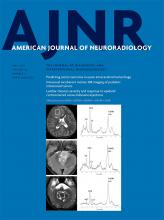Abstract
SUMMARY: Chimeric antigen receptor T-cell therapy is an exciting and rapidly emerging “fifth pillar” treatment for hematologic cancers. Unique treatment-related toxicities and cost remain a major hindrance to its widespread application. The commonly faced challenges with this innovative therapy, its neurotoxicity, and manifestation on neuroimaging studies, are reviewed.
ABBREVIATIONS:
- CAR
- chimeric antigen receptor
- CRS
- cytokine release syndrome
- CRES
- CAR-T-cell–related encephalopathy syndrome
What are Chimeric Antigen Receptor T-Cells?
Two major types of immunotherapies have been developed during the past decade; 1) monoclonal antibodies agents specific to target tumor, and 2) adoptive T-cell therapy, agents that mount an immune response against tumor cells. Chimeric antigen receptor (CAR) T-cells are the adoptive T-cell therapy agents that are genetically engineered to produce an immune response against tumor cells.1,2
Who Benefits from CAR T-Cell Therapy?
Since 2017, the US Food and Drug Administration has approved 2 CAR T-cell agents for 3 indications: 1) axicabtagene ciloleucel for relapsed/refractory diffuse large B-cell lymphoma, 2) tisagenlecleucel for pediatric and young adult leukemia, and 3) tisagenlecleucel for adult non-Hodgkin lymphoma. These therapies target, bind, and destroy cluster of differentiation 19 antigen, predominantly found in B-cell tumors.3⇓⇓–6
How Is CAR T-Cell Therapy Delivered to Patients?
Manufacturing of CAR T-cells involves 5 phases: 1) extraction of T-cells with an apheresis technique; 2) reprogramming of T-cells by disarmed virus vectors, which genetically modify T-cells to produce artificial protein receptors called chimeric antigen receptors, used to locate and bind the targeted tumor; 3) expansion and mass production of CAR T-cells and freezing when sufficient numbers are produced; 4) lymphodepletion, a reduction of the white blood cell load, making space for incoming reprogrammed CAR T-cells; and 5) infusion/treatment with CAR T-cells, in which cells multiply and mount an immune response against the targeted cancer cells. According to the current guidelines, patients are required to stay in the hospital from a few days to several weeks depending on their adverse effects profile. Posttreatment recovery time is approximately 2–3 months.7⇓⇓–10
What Are the Major Toxicities of CAR T-Cell Therapy and How Are They Graded?
Cytokine release syndrome (CRS) is the most commonly occurring toxicity in patients receiving CAR T-cell therapy followed by CAR-T-cell–related encephalopathy syndrome (CRES).
CRS results from immune activation resulting in elevated inflammatory cytokines. CRS-associated symptoms can range from fever, malaise, anorexia, and myalgias to end-organ dysfunction. There are 4 grades of CRS toxicity. Grade 1 comprises constitutional symptoms. Grade 2 includes hypotension that responds to fluids or low-dose vasopressors, hypoxia that responds to <40% O2, and grade 2 organ toxicities. Grade 3 encompasses hypotension requiring high-dose vasopressors, hypoxia requiring >40% O2, and grades 3 and 4 organ toxicities. Grade 4 also includes hypoxia requiring mechanical ventilation and grade 4 organ toxicities.11,12 Severe CRS toxicity can rarely progress into fulminant hemophagocytic lymphohistiocytosis.12
CRES-associated symptoms can range from mild neurotoxicity to more severe forms such as seizures, paralysis, raised intracranial pressure (ICP), papilledema, and cerebral edema. CRES is categorized into 4 grades based on neurologic assessment (orientation, naming of objects, ability to write a standard sentence, and counting backwards), raised ICP, and the presence of seizures or motor weakness. Grading of neurologic assessment is as follows: mild (grade 1), moderate (grade 2), severe (grade 3), and critical/obtunded (grade 4). The presence of raised ICP, seizures, or motor weakness comprise grades 3 and 4.13⇓–15
A study conducted by Gofshteyn et al16 concluded that the incidence of neurotoxicity in pediatric and young adult populations (∼45%) is similar to that found in the adult population (∼40%–42%). The study demonstrated that the occurrence of life-threatening neurotoxicity was lower in comparison with adults and all patients had neurologic recovery with no fatal outcomes.
What Are the Neuroradiologic Findings in Patients Receiving CAR T-Cell Therapy?
A study conducted by Davila et al17 at the National Institutes of Health showed that patients who underwent neuroimaging had unremarkable examination findings.
Santomasso et al13 described 2 forms of neurotoxicity: mild and severe. Mild neurotoxicity comprises delirium, tremor, and headaches. Severe neurotoxicity ranges among disorientation, loss of attention, partial-to-global aphasia, myoclonus, and seizures. All patients with mild neurotoxicity had unremarkable MR imaging findings of the brain. In addition, of the 14 patients with severe neurotoxicity, 9 patients also had unremarkable changes. Patients with positive MR imaging findings showed a nonspecific pattern of predominantly white matter involvement extending to the brain stem. These nonspecific changes can also be seen with migraines and chronic microvascular ischemia resulting from common conditions such as hypertension among others.18 Following symptom resolution, 2 of the remaining 5 patients with MR imaging–positive findings had reversal of the MR imaging changes.
What are the Neuroradiologic Recommendations in Patients Receiving CAR T-Cell Therapy?
Given the wide range of nonspecific brain findings and etiologies, the authors suggest a baseline pretreatment MR imaging to document any treatment-related changes. Given their immunocompromised state, these patients are prone to infections, which can result in the release of septic emboli into the bloodstream. This can lead to cerebritis and could further progress to abscess, advocating the use of contrast-enhanced MR imaging.19
What Are the Challenges in Implementing CAR T-Cell Therapy?
Despite its promising treatment response, health plan coverage and drug costs are barriers to access CAR T-cell therapy. Axicabtagene ciloleucel and tisagenlecleucel treatment costs are estimated at $373,000 and $475,000, respectively.20,21 The nondrug costs due to adverse effects, apheresis, and lymphodepletion therapy are not part of these drug regimens and can cost from $30,000 to $56,000.22 In addition, the facility costs to process and produce the final product, along with the use of cell therapy experts are enormous; treatment delivery, risk assessment, and legal counseling teams are important, costly, and essential.23 Currently, CAR T-cell therapy is not approved for Medicare patients. However, recently the US Centers for Medicare and Medicaid Services has proposed comprehensive nationwide coverage for CAR T-cell therapy.24
REFERENCES
- Received February 17, 2019.
- Accepted after revision March 6, 2019.
- © 2019 by American Journal of Neuroradiology












